
Euphorbia is a very large and diverse genus of flowering plants, commonly called spurge, in the spurge family (Euphorbiaceae). "Euphorbia" is sometimes used in ordinary English to collectively refer to all members of Euphorbiaceae, not just to members of the genus. Some euphorbias are commercially widely available, such as poinsettias at Christmas. Some are commonly cultivated as ornamentals, or collected and highly valued for the aesthetic appearance of their unique floral structures, such as the crown of thorns plant. Euphorbias from the deserts of Southern Africa and Madagascar have evolved physical characteristics and forms similar to cacti of North and South America, so they are often incorrectly referred to as cacti. Some are used as ornamentals in landscaping, because of beautiful or striking overall forms, and drought and heat tolerance.
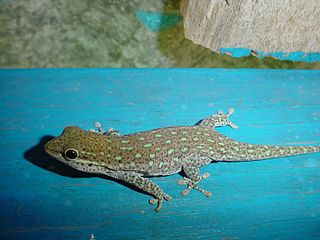
Phelsuma breviceps is a diurnal species of gecko that is native to south-west Madagascar and typically dwells on trees and bushes. Its diet in the wild consists mainly of insects.

Didiereaceae is a family of flowering plants found in continental Africa and Madagascar. It contains 20 species classified in three subfamilies and six genera. Species of the family are succulent plants, growing in sub-arid to arid habitats. Several are known as ornamental plants in specialist succulent collections. The subfamily Didiereoideae is endemic to the southwest of Madagascar, where the species are characteristic elements of the spiny thickets.
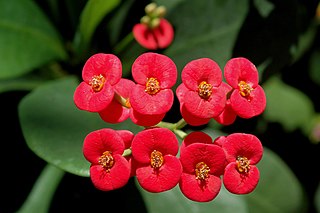
Euphorbia milii, the crown of thorns, Christ plant, or Christ thorn, called Corona de Cristo in Latin America, is a species of flowering plant in the spurge family Euphorbiaciae, native to Madagascar. The species name commemorates Baron Milius, once Governor of Réunion, who introduced the species to France in 1821. It is imagined that the species was introduced to the Middle East in ancient times, and legend associates it with the crown of thorns worn by Christ.
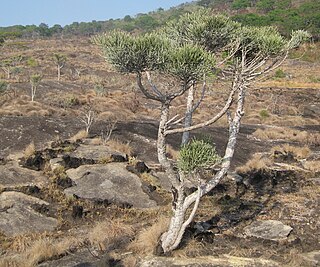
Euphorbia tirucalli is a tree that grows in semi-arid tropical climates. A hydrocarbon plant, it produces a poisonous latex that can cause blindness.

Euphorbia maritae is a species of perennial flowering plant in the family Euphorbiaceae. It takes its name from the discoverer, Marita Specks, who collected the first known specimen in Tanzania with her husband Ernst Specks in 1999.

Euphorbia ambovombensis is a species of plant in the family Euphorbiaceae. It is endemic to Madagascar. Its natural habitats are subtropical or tropical dry forests and subtropical or tropical dry shrubland. It is threatened by habitat loss.

Euphorbia arbuscula is a species of plant in the spurge family (Euphorbiaceae). It is endemic to the archipelago of Socotra in Yemen. Its natural habitats are subtropical or tropical dry forests and subtropical or tropical dry shrubland.
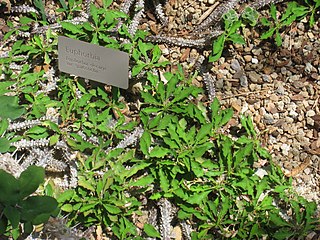
Euphorbia decaryi is a species of plant in the family Euphorbiaceae endemic to Madagascar. Its natural habitats are subtropical or tropical dry forests, subtropical or tropical dry shrubland, and rocky areas. It is threatened by habitat loss.
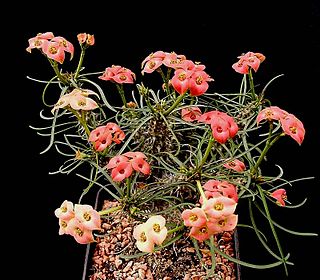
Euphorbia gottlebei is a species of plant in the family Euphorbiaceae. It is endemic to Madagascar. Its natural habitat is rocky areas. It is threatened by habitat loss.

Euphorbia leuconeura, the Madagascar jewel, is a species of plant in the family Euphorbiaceae. It is endemic to Madagascar. Its natural habitat is forest undergrowth in rocky areas. It can grow to a height of 1.8 m (6 ft), as a branching small tree, and propagates by shooting its seeds several feet into the air. It is threatened by habitat loss.
Euphorbia pellegrinii is a species of plant in the family Euphorbiaceae. It is endemic to Madagascar. Its natural habitat is subtropical or tropical dry lowland grassland. It is threatened by habitat loss.
Euphorbia pirahazo is a species of plant in the family Euphorbiaceae. It is endemic to Madagascar. Its natural habitat is subtropical or tropical dry forests. It is threatened by habitat loss.
Werner Rauh was an internationally renowned German biologist, botanist and author.

Euphorbia canariensis, commonly known as the Canary Island spurge, Hercules club or in Spanish cardón, is a succulent member of the genus Euphorbia and family Euphorbiaceae endemic to the Canary Islands. It is the plant symbol of the island of Gran Canaria.

The Euphorbiaceae are a large family, the spurge family, of flowering plants. In common English, they are sometimes called euphorbias, which is also the name of a genus in the family. Most spurges such as Euphorbia paralias are herbs, but some, especially in the tropics, are shrubs or trees, such as Hevea brasiliensis. Some, such as Euphorbia canariensis, are succulent and resemble cacti because of convergent evolution. This family occurs mainly in the tropics, with the majority of the species in the Indo-Malayan region and tropical America a strong second. A large variety occurs in tropical Africa, but they are not as abundant or varied as in the two other tropical regions. However, the Euphorbiaceae also have many species in nontropical areas such as the Mediterranean Basin, the Middle East, South Africa, and the Southern United States.

Kalanchoe rhombopilosa is a succulent plant species in the family Crassulaceae. This species of plant is endemic to southwest Itampolo, Madagascar. The species was described by Mannoni & Boiteau in 1947 and is indexed in Notul. Syst. (Paris) 13:153-154, (1947). The plant is a herbaceous perennial that grows to 10–20 cm in height.

Aloe sect. Lomatophyllum is a taxonomic section within the genus Aloe, comprising between 12 and 18 closely related species of Aloe from Madagascar and the Mascareigne islands.

Arboretum d'Antsokay or Antsokay Arboretum is a botanical garden near the city of Toliara in Madagascar. About 900 plant species grow in the Arboretum, 90% of these endemic to Madagascar, 80% of them considered to have medicinal value and many threatened with extinction. Lonely Planet and Rough Guides both list the Arboretum as the top attraction in Toliara.
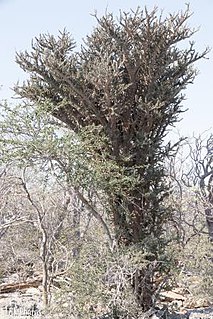
Alluaudia comosa is a rare species of flowering plant.


















